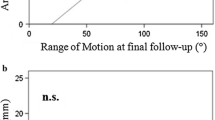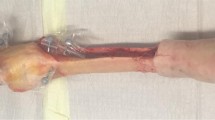Abstract
Many surgeons believe that increasing the tibial slope in total knee arthroplasty (TKA) is beneficial with regard to maximal postoperative flexion. Review of the clinical literature, however, does not confirm this hypothesis, neither does it give an answer to the question of how much flexion gain can be expected per degree extra tibial slope. The purpose of this study was, therefore, to evaluate and quantify the influence of tibial slope on maximal postoperative flexion in contemporary posterior cruciate ligament (PCL)-retaining TKA. Twenty-one cadaver simulations of a standard PCL-retaining TKA were studied while reproducing identical deep flexion femorotibial kinematics as documented by three-dimensional computer-aided videofluoroscopy from patients with well-functioning TKAs of the same design. In each knee the tibial component was consecutively implanted with 0° posterior slope, 4° posterior slope, and 7° posterior slope. Maximal flexion was recorded for each configuration. Average maximal flexion at 0° tibial slope was 104°, and increased significantly to 112° when the same knees were implanted with 4° tibial slope. Increasing the slope further to 7° again significantly improved average maximal flexion to 120°. When postoperative radiographic tibial slope was compared to maximal flexion, an average gain of 1.7° flexion for every degree extra tibial slope was noted. Increasing the tibial slope in PCL-retaining TKA does indeed improve maximal flexion before tibial insert impingement occurs against the femoral bone. The surgeon can expect an average gain of 1.7° flexion for every degree extra tibial slope.



Similar content being viewed by others
References
Akagi M, Ueo T, Matsusue Y, Akiyama H, Nakamura T (1997) Improved range of flexion after total knee arthroplasty. Bull Hosp Jt Dis 56:225–232
Akagi M, Nakamura T, Matsusue Y, Ueo T, Nishijyo K, Ohnishi E (2000) The bisurface total knee replacement: a unique design for flexion. J Bone Joint Surg Am 82-A:1626–1633
Anouchi YS, McShane M, Kelly F, Elting J, Stiehl J (1996) Range of motion in total knee replacement. Clin Orthop 331:87–92
Banks S, Bellemans J, Nozaki H, Whiteside L, Harman M, Hodge A (2003) Knee motions during maximum flexion in fixed and mobile bearing arthroplasties. Clin Orthop 410:131–138
Banks SA, Markovich GD, Hodge WA (1997) In vivo kinematics of cruciate retaining and substituting knee replacements. J Arthroplasty 12:297–304
Bellemans J, Banks S, Victor J, Vandenneucker H, Moermans A (2002) Fluoroscopic analysis of the kinematics of deep flexion in total knee arthroplasty. The influence of posterior condylar offset. J Bone Joint Surg Br 84-B:50–53
Bertin K, Komistek R, Dennis D, Hoff W, Anderson D, Lang T (2002) In vivo determination of posterior femoral rollback for subjects having a NexGen posterior cruciate-retaining total knee arthroplasty. J Arthroplasty 17:1040–1048
Bonnin M (1990) La subluxation tibial antérieure en appui monopodal dans les ruptures du ligaments croisés antérieure. Etude clinique et bioméchanique. Thèse Med. Lyon, No. 180
Dennis DA, Komistek RD, Colwell CE, Ranawat CS, Scott RD, Thornhill TS, Lapp MA (1998) In vivo anteroposterior femorotibial translation of total knee arthroplasty: a multicenter analysis. Clin Orthop 356:47–57
Jordan L, Siegel J, Olivo J (1995) Early flexion routine. An alternative method of continuous passive motion. Clin Orthop 315:231–233
Kim J, Myung-Sang M (1994) Squatting following total knee arthroplasty. Clin Orthop 313:177–186
Lizaur A, Marco L, Cebrian R (1997) Preoperative factors influencing the range of movement after total knee arthroplasty for severe osteoarthritis. J Bone Joint Surg Br 97-B:626–629
Migaud H, De Ladoucette A, Dohin B, Cloutier J, Gougeon F, Duquennoy A (1996) Influence of the tibial slope on tibial translation and mobility of non-constrained total knee prosthesis. Rev Chir Orthop Reparatrice Appar Mot 82:7–13
Nagamine R, White S, McCarthy D, Whiteside L (1995) Effect of rotational malposition of the femoral component on knee stability kinematics after total knee arthroplasty. J Arthroplasty 10:265–270
Schurman D, Parker J, Ornstein D (1985) Total condylar knee replacement. A study of factors influencing range of motion as late as two years after arthroplasty. J Bone Joint Surg Am 67:1006–1014
Stiehl J, Komistek RD, Dennis DA (1990) Detrimental kinematics of a flat on flat total condylar knee arthroplasty. Clin Orthop 365:139–148
Stiehl J, Dennis DA, Komistek RD, Keblish PA (2000) In vivo kinematic comparison of posterior cruciate ligament retention or sacrifice with a mobile bearing total knee arthroplasty. Am J Knee Surg 13:13–18
Uvehammer J, Karrholm J, Brandsson S, Herberts P, Carlsson L, Karlsson J, Regner L (2000) In vivo kinematics of total knee arthroplasty: flat compared with concave tibial joint surface. J Orthop Res 18:856–864
Walker P (1989) Requirements for successful total knee replacements. Design considerations. Orthop Clin North Am 20:15–29
Walker P, Garg A (1989) Range of motion in total knee arthroplasty. A computer analysis. Clin Orthop 262:227–235
Wasielewski R, Galante J, Leighty R, Natarajan R, Rosenberg A (1994) Wear patterns on retrieved polyethylene tibial inserts and their relationship to technical considerations during total knee arthroplasty. Clin Orthop 299:31–43
Author information
Authors and Affiliations
Corresponding author
Rights and permissions
About this article
Cite this article
Bellemans, J., Robijns, F., Duerinckx, J. et al. The influence of tibial slope on maximal flexion after total knee arthroplasty. Knee Surg Sports Traumatol Arthrosc 13, 193–196 (2005). https://doi.org/10.1007/s00167-004-0557-x
Received:
Accepted:
Published:
Issue Date:
DOI: https://doi.org/10.1007/s00167-004-0557-x




